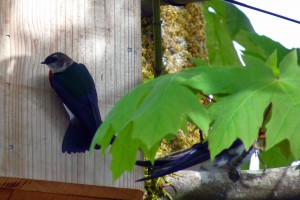A few weeks ago a fellow Gabriola birder confided that some days he wished he didn’t have a nest cam. At first I assumed he was referring to the amount of time he spends watching the screen. (I could relate to that.) But it turned out he wasn’t at all concerned about the nest cam’s addictive nature. He was, instead, embarrassed that he was privy to all kinds of avian hanky-panky, some of it, apparently, rather aggressive. (I will spare you the details, some of which were definitely not appropriate for the grocery store aisle in which we were chatting.) But I’d much rather watch that (I’d try to retain a scientific curiosity) than to be subject to watching the death, over a period of many days, of all the violet-green swallows inside my nest box. That’s what happened a few years ago.
It all started when the mother swallow flew into the nest box one evening and, rather than feed the chicks, she lay against the side of the box. She’d never done anything like that before. For hours the only activity in the nest box was hungry babies gaping and peeping for food. The mother just lay there, sometimes moving her head to preen, but not much else. Within 24 hours she was absolutely still. The babies continued peeping. It took a while before I let it sink in – she was dead.
I was in shock. But, as with any death, there were immediate practical tasks to take care of. The problem was that I didn’t have a clue how to proceed. Should I remove her dead body from the nest? (I was worried about decomposition and the bugs that would appear to feast on her corpse.) Or should I leave it, so as not to disturb the babies? I called every organization I could think of for help. No one had any definitive advice. Most explained that it depended on what happened next. I was advised to watch and see if the male began to feed the babies.
I watched, obsessively. It was just after noon when he arrived – with food! Jubilant, I began cheering him on and talking up the stunning qualities of fathers to friends and neighbours who just raised their eyebrows. Unfortunately, my happiness was short-lived. Over the next week, in spite of the efforts of the father swallow, one by one, all three babies died. After the second one died, I stopped watching and coerced my husband into checking the screen every hour or so and reporting in with a simple thumbs-up or a thumbs-down. Words were too painful. Actually, it’s still too hard to write in any detail about that heartbreaking week.
Eventually I called the folks at the BC Interagency Wild Bird Mortality Investigation Protocol (BCIWBMIP) to try and find out what had happened. At that point, after lots of research, I could only come up with two possible scenarios. One: the mother was a healthy bird that had barely escaped a predator, made it back to the nest, then died of a heart attack brought on by the stress of the incident. Or two: the mother contracted an illness and passed it on to the babies. Neither of these possibilities fit well with the sad events that had occurred.
The woman I spoke to couldn’t give me a definitive answer, and said it was too late to find out for sure. Then she walked me through what could have happened IF I had called them earlier, just after the mother died. I thought I should share this with you – although I hope you’re never in this position. I am assuming that all province’s have their own version of the BC Interagency Wild Bird Mortality Investigation Protocol.
WHEN A BIRD DIES
I learned – too late – that I could have found out what caused the deaths IF I HAD DONE THE FOLLOWING.
• Remove the mother swallow’s body from the nest, within 12 hours of her death, using gloves and taking sanitary precautions – but only if I could do so without disturbing the babies too much. (I’m still not sure how I would have predicated or accomplished that.)
• Store the corpse in a double plastic bag labelled with date of death, location, and species.
• Keep the body cool until instructed where to send it by BCIWBMIP
• Call BCIWBMIP at 1-866-431-BIRD
THREE DEAD BIRDS?
BCIWBMIP is also interested in knowing if you discover three or more dead birds within the same location, or dead waterfowl, shorebirds, eagles, hawks, or owls.
DEFORMED BEAKS/BILLS?
The US Geological Survey at The Alaska Science centre asks that you report any bird with a beak deformity (dead or alive) to them by filling out the form at: http://alaska.usgs.gov/science/biology/landbirds/beak_deformity/observerreport.html.
Okay, enough of death! I promise something less depressing next month!!




Thanks for your comment John. I agree – nestcamming adds a whole other dimension, complete with a plethora of attachments and emotions, to the birding experience.
Your comments and observations are well made and are a lesson for all who observe birds in this way. For years we have not known what has been happening in nest boxes and only discovered them if we checked them after the season. With technology comes more intervention and more consideration for the species we are observing. On the downside comes a guilt and the resurgence of respect for life and a responsibility to ensure that the species continues to flourish. I think this is an admirable cause which comes with its own plethora of attachments but guarantees that those bird species that are in jeopardy will continue to flourish for others to enjoy. Let’s help when we can and learn from our observations so others can continue carrying the torch.